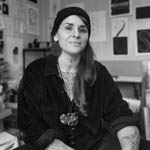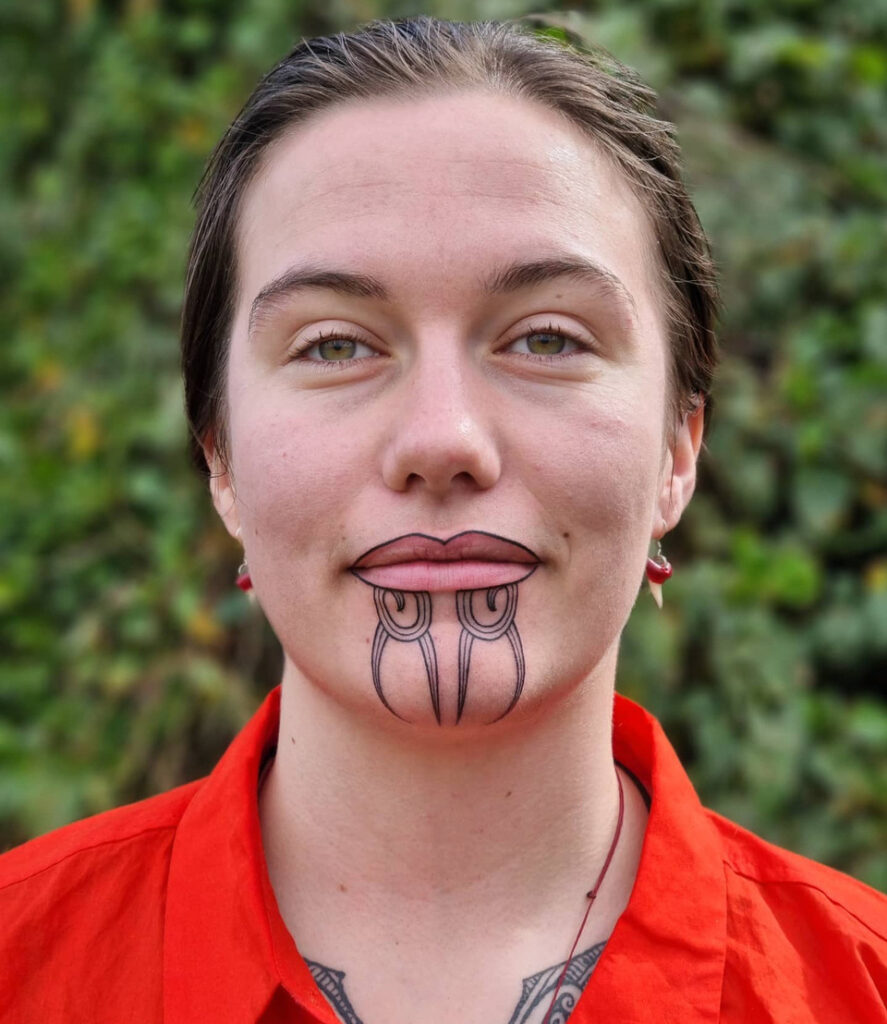Rangimarie Sophie Jolley (Waikato-Tainui) and Sian Montgomery-Neutze (Muaūpoko, Ngai Tara) introduce the ways we sense Māori art.
“Te toi whakairo, ka ihiihi, ka wehiwehi, ka aweawe te ao katoa”
“Artistic excellence makes the world stand up in wonder”
When in the presence of artistic excellence, there’s a moment of truth – something that compels us out of ourselves and in that moment, we are struck. We’ve all had that feeling, whether in the shimmer of dawn or the whim of an artist’s brush, we know the exchange that happens and what’s been created. Art is a magnificent bridge for that feeling.
Within the realm of toi Māori, we aren’t just seeking the feeling of contemplation, we’re experiencing a deep knowing of the answers inside of us. We access this knowing through multiple senses across time immemorial. In te reo Māori, one way we describe this experience is through the word rongo: to sense, smell, hear, feel, taste, perceive and ultimately, to have a sense of awareness.
That all of these sensations can be communicated using one word is no accident – it emphasises ‘sensation’ on the experience itself. The word, ‘rongo’, captures the interconnectedness and activation of multiple ‘senses’ as part of that experience.
The role of Ngā Toi (the arts) in our lives
In Aotearoa (New Zealand), our indigenous art practices include our visual languages, performing arts, music, storytelling, oratory and more. Many of these practices are shared with our whanaunga (relatives) throughout Te Moananui a Kiwa (the Pacific) and therefore inherently connect us to our wider cultural narratives.
For Māori, our toi practices are a living, breathing part of our everyday lives. They are deeply entwined with our mātauranga (knowledge systems), our tikanga (cultural practices) and are an expression of our relationship with our world. They continuously shape our relationships with nature and each other in an undeniably symbiotic way. Toi Māori provides an outlet for engaging with and interpreting our world. It is a language unto itself that enables the articulation and materialisation of our stories, perspectives, ideas, hopes and dreams.
Ngā toi is an expression of what we need to live beyond our own survival. It gives voice to our historical and ongoing relationship with our world and with each other. For example, taonga Māori such as kākahu (cloaks) are typically created with the intention of being handed down from one generation to the next. Our whare (traditional houses) are adorned with whakairo (carvings) tukutuku (woven panels) and kōwhaiwhai (paintings) which all use unique design conventions to capture iwi (tribal) narratives and whakapapa (genealogy) as a way of communicating knowledge across generations. Tā moko (Māori tattoo) uses iwi-centric design language to tell us who someone is, where they come from and what role they play in their community. In this way, ngā toi is part of an integrated system of knowing.
The Process
For Māori, the tikanga (process or practice) of producing work is of equal importance to the end result. The rituals and processes involved in the harvesting and preparation of materials, the creation of tools and tikanga whakahaere (rules of engagement with each other, our environment and our knowledge systems) all go hand in hand with the work. It’s an integrated system, where the knowing of each step involved in the creator’s process enriches the work.
Every time we engage with ngā toi Māori, we’re working with multiple senses and bodies of knowledge. The relationship between all of these things leads to a shared understanding in a multi-dimensional space. Take the following work as an example.
This piece speaks to the whakapapa of moko (Māori tattoo). The ngārahu (black ink) is made (by the artist) from kauri gum soot, which was one of our first forms of moko ink. The kōkōwai (red earth pigment) holds huge significance in our cultural narratives. It was gathered and prepared by the artist for this work, and in this context, it represents the hōpara makaurangi (a form of body adornment that pre-dates moko), toto (blood) and whenua (land). All of which are central to our narratives related to moko.
The vertical lines reference haehae (lacerating the skin) one of our earliest forms of skin marking. They are intersected by horizontal lines, which form uhi (chisels used for tā moko), one of the earliest tools used to create body markings. Each of the materials, resources and their preparation is as significant as the patterns used. All of these have been woven together using the principles and elements of Māori visual language to articulate elements of narrative through a contemporary work.
The Seer and the Seen
Through the multidimensionality of toi Māori, we experience three holistic concepts through rongo. We refer to these as ihi, wehi and wana. They describe the relationship between the seen and unseen, the creator and the receiver & the known and the unknown.
Ihi: This is the feeling of excitement, the thrill, power, charm or personal magnetism that is often wielded by a performer. It can also be used to describe the attributes of a speaker, an interactive installation or the catalytic moment by which one is enraptured.
Wehi: This describes all that is awesome. Where wehi exists in response to awe, it is also in reaction to ihi.
Wana: This refers to the moment of thrill, the rousing, inspiring, stimulating, passionate gusto that sits alongside ihi and wehi.
Through these concepts, we can see that rongo is the bridge between what has been presented and what has been perceived. In English, there are few words to capture this feeling. We might try to articulate it as rapture, awe or even something as simple as magic.
Conclusion
Central to our need to create is our motivation to communicate. As living elements of the natural world, we’re always drawn to the ways in which we communicate both our human state and that of the world around us. This communication is a relationship, one that requires something to be perceived and someone to perceive it. In te ao Māori, this communication is as important for the creator as it is for the audience. Their relationship is captured in the use of the word rongo – we hear, see, feel, taste, smell or perceive that which exists between us. Ka rongo au.
About Sian Montgomery-Neutze
 Sian Montgomery-Neutze (Muaūpoko, Ngāi Tara, Ngāti Apa) is an incredible force and proponent of Te Ao Māori me ōna tikanga. A moko practitioner and ringatoi based in Porirua, Sian has worked across multiple sectors as a Mātauranga Māori Advisor, Visual Arts Teacher, Resource Developer, Te Reo Translator and Project Coordinator. She currently focuses her work on tā moko and earth pigments, using natural elements to perfect the visual re-telling of our stories. Sian’s work is steeped in mātauranga Māori. She holds a Master’s Degree in Mātauranga Māori from Te Wānanga o Raukawa, a Post-Graduate Diploma in Māori Visual Arts from Massey University as well as diplomas in Whakairo and Adult Education..
Sian Montgomery-Neutze (Muaūpoko, Ngāi Tara, Ngāti Apa) is an incredible force and proponent of Te Ao Māori me ōna tikanga. A moko practitioner and ringatoi based in Porirua, Sian has worked across multiple sectors as a Mātauranga Māori Advisor, Visual Arts Teacher, Resource Developer, Te Reo Translator and Project Coordinator. She currently focuses her work on tā moko and earth pigments, using natural elements to perfect the visual re-telling of our stories. Sian’s work is steeped in mātauranga Māori. She holds a Master’s Degree in Mātauranga Māori from Te Wānanga o Raukawa, a Post-Graduate Diploma in Māori Visual Arts from Massey University as well as diplomas in Whakairo and Adult Education..
About Rangimarie Sophie Jolley
 Rangimarie Sophie Jolley (Waikato-Tainui) is a māmā, writer, editor and art critic whose ear is always resting on the heartbeat of ngā toi Māori and the Māori Writers’ community. She is a writer of prose, poetry, children’s stories, and long and short-form works of fiction & non-fiction. A weaver of words and an alchemist of change, she is a founding member of the Hine Pae Kura and Toi Wāhine Māori female artist collectives. In 2014, she published a collection of short stories for children alongside Robyn Kahukiwa and has since been involved in numerous storytelling workshops and poetry readings. Her poetry has been included in exhibitions in Porirua, Wellington, Auckland, Tāneatua, Melbourne and New York. Her work focuses on exploring the perspectives of Māori women. Rangimarie is second to none at facilitating space and making room for the wānanga we seek to have as Māori, as ancestors and as descendants.
Rangimarie Sophie Jolley (Waikato-Tainui) is a māmā, writer, editor and art critic whose ear is always resting on the heartbeat of ngā toi Māori and the Māori Writers’ community. She is a writer of prose, poetry, children’s stories, and long and short-form works of fiction & non-fiction. A weaver of words and an alchemist of change, she is a founding member of the Hine Pae Kura and Toi Wāhine Māori female artist collectives. In 2014, she published a collection of short stories for children alongside Robyn Kahukiwa and has since been involved in numerous storytelling workshops and poetry readings. Her poetry has been included in exhibitions in Porirua, Wellington, Auckland, Tāneatua, Melbourne and New York. Her work focuses on exploring the perspectives of Māori women. Rangimarie is second to none at facilitating space and making room for the wānanga we seek to have as Māori, as ancestors and as descendants.




